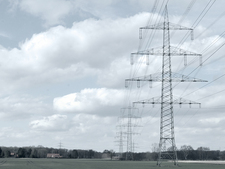-
Topics
subnavigation
Topics
Electromagnetic fields
- What are electromagnetic fields?
- Static and low-frequency fields
- Radiation protection relating to the expansion of the national grid
- High-frequency fields
- Radiation protection in mobile communication
Optical radiation
Ionising radiation
- What is ionising radiation?
- Radioactivity in the environment
- Applications in medicine
- Applications in daily life and in technology
- Effects
- What are the effects of radiation?
- Effects of selected radioactive materials
- Consequences of a radiation accident
- Cancer and leukaemia
- Genetic radiation effects
- Individual radiosensitivity
- Epidemiology of radiation-induced diseases
- Ionising radiation: positive effects?
- Risk estimation and assessment
- Radiation protection
- Nuclear accident management
- Service offers
-
The BfS
subnavigation
The BfS
- About us
- Science and research
- Laws and regulations
- BfS Topics in the Bundestag
- Links
What are high-voltage lines?
The electricity supply at home has a voltage of 230 volts (230 V). However, much higher voltages are used to deliver electricity to homes. Overhead lines carry up to 380.000 volts (380 kV) to transport electricity from power stations to towns and urban centres.
High voltages are more suitable than low voltages for the transmission of electrical energy because loss of energy due to conductor resistance is less with high voltages. However, the voltage cannot be increased indefinitely. Therefore, the voltage on a wire is chosen according to the distance to be covered for transmission and to the power needed by the recipient.
| Name | Voltage | Example / application | |
|---|---|---|---|
| Low-voltage | Up to 1.000 V | 230/400 V; supply to residential and commercial users | |
| High-voltage | Medium-voltage | > 1.000 V | 10 kV, 20 kV, 30 kV; local/regional distribution grids, supply to villages and industry |
| High-voltage | > 30.000 V (limit is not uniformly defined) | 110 kV; supply to relatively small power plants, regional transport grids, supply to towns and large-scale industry | |
| Extra high voltage | > 150.000 V (limit is not uniformly defined) | 220 kV and 380 kV; supply to large power plants, wide-area transmission grids, power trading | |
Direct and alternating current
When power grids were first developed in the early 20th century, alternating current was technically required to operate high-voltage grids. In contrast to direct current, alternating current constantly changes flow direction, in Western Europe 100 times per second. This equals a frequency of 50 Hertz (50 Hz).
Today it is possible to operate high-voltage grids using direct current. This helps avoid loss of energy, caused by the changes of flow direction in the case of alternating current. Therefore, the high voltage direct current (HVDC) transmission is an alternative to ac-technology. Up to now HVDC is mainly applied to transmit electricity via sea cable in West Europe.
Overhead lines and underground cables
Overhead lines and underground cables are used for overland transmission of electrical energy.
So-called ropes are used as electric conductors in the case of overhead lines. Since ropes – other than cables – are not surrounded by an insulating layer, they are separately attached to masts out of the reach of people. High and extra high voltage lines are mostly overhead lines in Germany. However, low-voltage lines to supply residential users are also designed as overhead lines with roof stands, particularly outside of large cities.
Underground cables have one or several conductors, which are individually insulated to prevent them from coming into contact with each other. As a result, the conductors can be laid at a much closer distance to each other than in the case of overhead lines. Underground lines are mainly used in the low-voltage range, i.e. to supply residential and commercial users. Extra high voltage lines can be installed as underground cables, too.
Gas insulated transmission lines are also being discussed which have, however, only been used over very short distances in Germany up to now. They are comparable to a high voltage cable. Gas insulated transmission lines are made up of an aluminium conductor laid within an aluminium tube. For insulation, the tube is filled with a gas.
Typical overhead lines
The voltage applied for an overhead transmission line is not obvious at a glance. However, the masts give some clues:
- high- and extra high voltage lines are usually mounted to high steel lattice masts,
- smaller wood, concrete or tubular steel masts are used for low- and medium voltage lines.
Taking a closer look at the conductor ropes can give an idea of the voltage level:
Extra high voltage lines:
In the case of 220 and 380 kV - lines, respectively, the conductor rope often consists of two, or three to four, single ropes which are parallel and close to each other (conductor bundles). Spreaders of a length of a few centimetres are mounted between the single ropes at regular distances of a few metres as can be seen in the above picture showing the 380 kV overhead line.
More information
The Video "Stromleitungen und Strahlenschutz" (in German only) answers many questions related to voltage lines and radiation protection.
State of 2017.10.23



